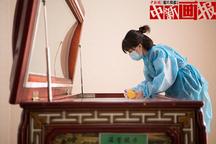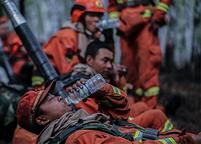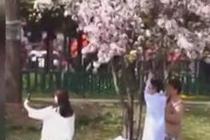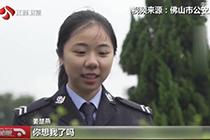 жаЙњЪеИДЮїФЯЩГШКЕК70жмФъМЭФюЛюЖЏжагЂЮФЖдееЗЂбд(5)
жаЙњЪеИДЮїФЯЩГШКЕК70жмФъМЭФюЛюЖЏжагЂЮФЖдееЗЂбд(5)

 ВЮгыЛЅЖЏЁЁ
ВЮгыЛЅЖЏЁЁ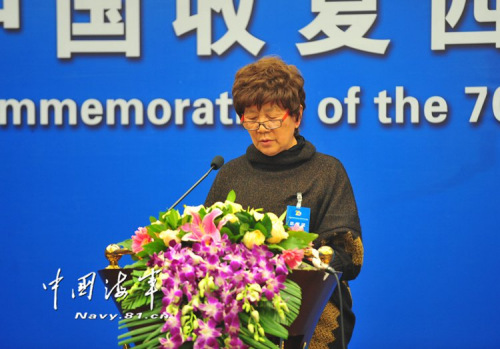
ЙигкМЭФюЪеИДЮїФЯЩГШКЕКЦпЪЎжмФъЕФНВЛА
СжЛЊЧф ЪБШЮЪеИДааЖЏжИЛгЙйСжзёжЎХЎ
ЁЁЁЁИїЮЛСьЕМЁЂИїЮЛЧАБВЁЂХѓгбУЧЃК
ЁЁЁЁПЙеНЪЄРћКѓЃЌжаЙњЪеИДЮїЩГКЭФЯЩГШКЕКЃЌЖдгкЮЌЛЄжаЙњжїШЈЭъећЪЧвЛИіОпгажиДѓРњЪЗвтвхЕФааЖЏЁЃЦпЪЎФъЧАЮвЕФИИЧзСжзёгаавЗюУќзщНЈСЫЪеИДЮїФЯЩГШКЕКЕФЁАЧАНјНЂЖгЁБЃЌВЂзїЮЊжИЛгЙйДјЖгЪеИДСЫЮїЩГКЭФЯЩГШКЕКЁЃЮвзїЮЊСжзёЕФГЄХЎЃЌФмВЮМгетИіДѓЛсВЂдкДЫЗЂбдЩюИаШйавЁЃ
ЁЁЁЁЮвУЧСжМвПЩвдЫЕЪЧКЃОќЪРМвЃЌЮвИИЧзЕФдјЪхзцИИЃЌвВОЭЪЧЮвЕФЬЋЪхзцИИЪЧСждђаьЃЌЮвзцИИСжГЏъивВдјЙЉжАЧхГЏББбѓЫЎЪІКЭУёЙњКЃОќЁЃЮвЕФИИЧзГіЩњгк1905ФъЃЌЪмМвЭЅЕФбЌЬеЃЌЫћДгаЁОЭСЂжОБЈаЇзцЙњЁЃЧрФъЪБЦкЫћОЭЖСгкбЬЬЈКЃаЃКЭТэЮВКЃаЃЃЌКѓБЯвЕгкгЂЙњЦгДФУЉЫЙКЃОќбЇаЃКЭЛЪМвКЃОќбЇдКЃЌЛЙдјБЛХЩЭљЕТЙњбЇЯАЧБЭЇЁЃ1939ФъЛиЙњКѓЧыУќЕЃШЮСЫКЃОќВМРзгЮЛїзмЖгЕкЮхДѓЖгДѓЖгГЄЃЌдкГЄННУцЩЯКЭШеПмеЙПЊСЫЫЎРзеНЁЃ1945Фъ8дТГіШЮЙњУёеўИЎзЄУРЙњДѓЪЙЙнКЃОќИБЮфЙйЃЌВЛОУКѓНгШЮжаЙњКЃОќзЄУРНгНЂВПЖгЕФжИЛгЙйЃЌНгЪеУРдЎЕФ8ЫвОќНЂЃЌБрЖгДЉдНМгРеБШКЃЃЌКсЖЩЬЋЦНбѓЃЌгк1946Фъ7дТЛиЕНзцЙњЁЃЭЌФъФъЕзДјСьЁАЧАНјНЂЖгЁБЪеИДСЫЮїЩГКЭФЯЩГШКЕКЁЃ1949ФъдкАйЭђалЪІЙ§ДѓНжЎМЪЫћТЪСьЙњУёЕГКЃЗРЕкЖўНЂЖгЦ№вхЃЌБЛУЋжїЯЏКЭжьзмЫОСюЪЂдоЮЊФЯОЉНУцЩЯЕФзГОйЁЃНтЗХКѓЫћдјЯШКѓЕЃШЮЛЊЖЋКЃОќЕквЛИБЫОСюЁЂОќЪТбЇдККЃОќЯЕжїШЮЁЂКЃОќбЇдКИБдКГЄЁЂЖЋКЃНЂЖгИБЫОСюЁЃЫћЛЙЪЧЕквЛНьЕНЕкЮхНьШЋЙњШЫУёДњБэДѓЛсДњБэКЭЕквЛНьеўаШЋЙњЮЏдБЛсЮЏдБЃЛвЛЁЂЖўЁЂШ§НьЙњЗРЮЏдБЛсЮЏдБЁЃ1955ФъБЛЪкгшЩйНЋОќЯЮЃЌЛёвЛМЖНтЗХбЋеТЁЃ1979ФъЫћдкЩЯКЃВЁЪХЃЌШЅЪРЧАЃЌЛЙАбЮвУЧНуУУНаЕНДВЧАЃЌШУЮвУЧКЭЫћвЛПщГЊЁАИшГЊзцЙњЁБЁЃетОЭЪЧЮвЕФИИЧзЃЌЫћОпгажаЙњКЃОќОќШЫЕФСМКУЫижЪЃЌвЛЩњзЗЧѓЙтУїЃЌШШАЎзцЙњЃЛЫћЪЧвЛИіжАвЕОќШЫЃЌвЛИіИяУќОќШЫЃЌвЛИіЙВВњЕГдБЃЌИјЮвУЧСєЯТСЫаэЖрЛГФюКЭаэЖрЫМПМЁЃ
ЁЁЁЁФЯЩГШКЕКЁЂЮїЩГШКЕКЁЂжаЩГШКЕКЁЂЖЋЩГШКЕКздЙХОЭЪЧЮвЙњЕФЙЬгаСьЭСЃЌЪЧЮвЙњШЫУёЪРЪРДњДњаСЧкРЭзїЕФЕиЗНЃЌЮїЩГШКЕКЃЌжаЙњЙХУћЦпжобѓЃЌЧЇРяГЄЩГЃЌжСНёСєЯТвдУїГЏЛЪЕлФъКХУќУћЕФгРРжШКЕККЭаћЕТШКЕКЕФУћГЦЃЛФЯЩГШКЕКЃЌжаЙњЙХУћЭђРяЪЏЬСЃЌгждјУћЭХЩГШКЕКЃЌЦфжагавджЃКЭУћзжУќУћЕФжЃКЭШКНИЃЌвджЃКЭЫцааШЫдБУћзжУќУћЕФОАКыЕКЁЂвќЧьШКНИЁЂЗбаХЕККЭТэЛЖЕКЁЃдчдкжаЙњЧхГЏЧЌТЁФъМфГіАцЕФЁЖКЃЙњЮХМћТМЁЗОЭвбОНЋФЯЩГШКЕККЭЮїЩГШКЕКУїУїАзАзЕиСаШыжаЙњАцЭМЃЌВЂЧвЕУЕНСЫЙњМЪЩЯИїЙњЕФЙЋШЯКЭМЧдиЃЌетЪЧВЛељЕФЪТЪЕЁЃ
ЁЁЁЁШеБОЧжТдепдкЕкЖўДЮЪРНчДѓеНжаеМСьСЫЮвФЯКЃжюЕКЁЃ1945ФъЫцзХУЫОќЕФВЛЖЯЪЄРћЃЌШеОќж№ВНДгЧжеМЕФЮїФЯЩГШКЕКЕКНИЩЯГЗзпЃЌЖўеНЪЄРћКѓЃЌЗЈЙњжиЗЕдЖЖЋЃЌЦфОќНЂЖрДЮЧжШыЮвЙњЮїФЯЩГШКЕККЃгђЃЌЗЦТЩБіЭтНЛВПЛЙЙЋШЛЩљГЦгІНЋФЯЩГШКЕКЛЎШыЗЦТЩБіЙњЗРЗЖЮЇЁЃжаЙњеўИЎдкПЙеНЪЄРћКѓЃЌМДПЊЪМГяЛЎВЂзМБИЪеИДЪТвЫЃЌЮвИИЧзТЪСьЕФУРдЎОќНЂЛиЙњКѓЃЌдкПЙеНжаЦДОЁбЊБОЕФжаЙњКЃОќВХЛжИДСЫЪеИДФЯКЃжюЕКЕФФмСІЁЃ1946Фъ7дТЯТбЎЃЌЙњУёеўИЎОіЖЈгЩЙуЖЋЪЁеўИЎИКд№НгЪеФЯКЃжюЕКЁЃ8дТЯТбЎЃЌааеўдКгжбЕСюФкеўЁЂЭтНЛЁЂЙњЗРЕШВПажњЙуЖЋЪЁеўИЎДгЫйНгЪеЮїЩГКЭФЯЩГШКЕКЁЃИїВПЖрДЮейПЊСЫСЊЯЏЛсвщбаОПЃЌОіЖЈОпЬхЗжЙЄЯИНкЁЃ10дТЃЌКЃОќзмЫОСюВПДгУРЙњжЇдЎжаЙњКЃОќЕФОќНЂжаЬєбЁЛЄКНЧ§ж№НЂЁАЬЋЦНЁБКХЁЂЗДЧБбВТпНЂЁАгРаЫЁБКХвдМАЬЙПЫЕЧТННЂЁАжавЕЁБКХЁЂЁАжаНЈЁБКХзщГЩЁАЧАНјНЂЖгЁБЃЌШЮУќЮвИИЧзЮЊжИЛгЙйЃЌЕБЪБКЃОќзмЫОСюВПЕкЖўЪ№ЕФЩЯаЃПЦГЄвІШъюкЮЊИБжИЛгЙйЃЌНјзЄФЯЩГШКЕККЭЮїЩГШКЕКЁЃЮвИИЧзВЛдИвтВЮМгЕБЪБвбОБЌЗЂЕФФкеНЃЌЖјЧвЮЊФмЙЛКДЮРЙњМвжїШЈЖјОЁКЃОќОќШЫЕФд№ШЮЃЌаРШЛЪмУќЁЃ
ЁЁЁЁ1946Фъ10дТ29ШеЃЌЁАЧАНјНЂЖгЁБдкГЄНПкМЏНсЃЌБрЖгФЯЯТЁЃ11дТ2ШеНЂЖгЪЛжСЛЂУХЁЃ11дТ3ШеЃЌЮвИИЧзКЭвІШъюкЃЌДјСьВЮФБСжЛРеТЁЂеХО§ШЛЁЂЁАЬЋЦНЁБКХНЂГЄТѓЪП
ЂЁАгРаЫЁБКХНЂГЄСѕвЫУєЁЂЁАжавЕЁБКХНЂГЄРюЖиЧЋЁЂЁАжаНЈЁБКХНЂГЄеХСЌШ№ГЫХкЭЇжСЙужнЃЌЛсМћСЫеХЗЂПќЁЂТозПгЂЕШЙуЖЋЗНУцЕФОќеўЪзФдЃЌгНггЩЙуЖЋЪЁеўИЎЮЏХЩЕФНгЪеФЯЩГШКЕКзЈдБЁЂЪЁеўИЎЙЫЮЪТѓдЬшЄЃЌНгЪеЮїЩГШКЕКзЈдБЁЂЪЁеўИЎЮЏдБЯєДЮвќЮЊЪзЕФЙуЖЋЪЁеўИЎИїЛњЙиЕФДњБэвдМАзЈвЕПМВьШЫдБЁЂВтСПШЫдБЕЧНЂЃЌвЛЕРЧАЭљЮїЩГШКЕККЭФЯЩГШКЕКЁЃ11дТ6Ше ЁАЧАНјНЂЖгЁБДгЛЂУХЦєКНЃЌ9ШеЕжДяКЃФЯЕКгмСжИлЁЃгЩгкЖдФЯКЃЕФЦјЯѓЁЂЫЎЮФЬѕМўЛЙВЛЪьЯЄКЭеЦЮеЃЌКНЯпЭМвВВЛУїШЗЃЌЭЈбЖЩшБИЬѕМўЩаЧЗШБЃЌЮвИИЧзЫћУЧзіСЫДѓСПЕФзМБИЙЄзїЃЌАДееМЦЛЎЙКжУСЫвЛХњЪЪгІЩККїНИКНааЕФгцгУФОДЌЃЌЙЭЧыСЫЪ§ЪЎУћЪьЯЄЮїЩГКЭФЯЩГШКЕКЕФгцЙЄЃЛВЂЯђЕБЕиЕФгцРЯДѓЧыНЬдкФЯКЃКНааЕФОбщЃЌЕУЕНСЫЫћУЧгУгкФЯЩГВЖРЬзївЕжСЮЊефЙѓЕФЁЖИќТЗВОЁЗЃЌВЂвдДЫЮЊВЮПМЃЌбщжЄКЭаоИФСЫдЄЯШФтЖЉЕФКНЯпКЭКНааМЦЛЎЁЃ
ЁЁЁЁгЩгкЖЋББМОЗчКЭДѓгъЃЌЬьЦјГЩСЫГіКНЕФзюДѓеЯАЁЃОќЧщНєЦШЃЌЮЊељШЁОЁПьНјзЄФЯЩГШКЕККЭЮїЩГШКЕКЃЌЮвИИЧзКЭвІШъюкОіЖЈЃКЁАЧАНјНЂЖгЁБЗжЮЊСНИіЗжНЂЖгЃЌгЩЮвИИЧзТЪСьЁАЬЋЦНЁБКХЁЂЁАжавЕЁБКХзщГЩФЯЩГШКЕКЗжНЂЖгЃЛгЩвІШъюкТЪСьЁАгРаЫЁБКХЁЂЁАжаНЈЁБКХзщГЩЮїЩГШКЕКЗжНЂЖгЁЃ
ЁЁЁЁ11дТ27ШеЮїЩГШКЕКЗжНЂЖгЦєКНЃЌ 28ШеСшГПЪЛЕжЮїЩГШКЕКЖЋВПЕФСжЕКЃЌ12дТ3ШеЃЌжабыИїВПЕФДњБэЁЂЙуЖЋЪЁеўИЎНгЪеЙйдБКЭзЄЕКШЫдБЃЌЮЊЪеИДЮїЩГШКЕКМЭФюБЎНвФЛЃЌВЂвдЁАгРаЫЁБКХНЂУћжиаТУќУћСжЕКЮЊгРаЫЕКЁЃ4ШеЃЌЗжНЂЖгЛЙбВЪгСЫЮїЩГШКЕКЮїВПЕФгРРжШКЕКЕШЃЌВЂУќУћАыТЗЕКЮЊжаНЈЕКЁЃ12дТ5ШеЮїЩГШКЕКЗжНЂЖгЫГРћЗЕЛигмСжИлЁЃ
ЁЁЁЁЕБЪБЮвИИЧзТЪСьЕФФЯЩГШКЕКЗжНЂЖгвбОСНДЮГіКНЃЌЖМЦШгкЗчРЫВЛЕУВЛЗЕЛиЁЃЫћГаЪмзХМЋДѓЕФбЙСІЃЌзщжЏКЮБўВФЕШжївЊИКд№ЙцЛЎКНЯпЕФШЫдБЃЌжиаТжЦЖЉСЫГіКНМЦЛЎЁЃ12дТ9ШеЃЌЮвИИЧзДјСьФЯЩГЗжНЂЖгдйДЮЪЛГігмСжИлЃЌЯШЯђдНФЯКЃАЖЗНЯђКНааЃЌБмПЊЧПДѓЕФКЃСїКЭДѓгПДѓРЫЕФзшАЃЌШЛКѓЪЪЪБЕизЊЯђЮїЩГШКЕКЃЌдйжБВхФЯЩГШКЕКЁЃРњОШ§ЬьМшФбКНааЃЌ12ШеЗжНЂЖгжегкЕжДяСЫФЯЩГШКЕКЕФЛЦЩНТэжХЁЃЮвИИЧзТЪЙйБјКЭеўИЎЙйдБЃЌСаЖгОйааНгЪеФЯЩГШКЕКЁЂМЭФюБЎНвФЛКЭЩ§ЙњЦьЕфРёЃЌвдЁАЬЋЦНЁБКХНЂУћжиаТУќУћЛЦЩНТэжХЮЊЬЋЦНЕКЃЌВЂЖдКЃЕКЗРгљзіСЫВПЪ№ЁЃ12дТ15ШеЃЌЗжНЂЖгбВЪгСЫФЯЩГжюЕКЃЌвдЁАжавЕЁБКХНЂУћжиаТУќУћЬњжХЮЊжавЕЕКЁЃ
ЁЁЁЁ1946Фъ12дТ25Ше ЁАЧАНјНЂЖгЁБЫФНЂПа§ЙужнЁЃ1947ФъдЊЕЉЃЌНЂЖгдкЁАЬЋЦНЁБКХОќНЂЕФКѓМзАхОйааСЫЪеИДФЯЩГЁЂЮїЩГШКЕКМЧепеаД§ЛсЃЌЮвИИЧзДњБэНЂЖгЯђжаЭтМЧепКЭЩчЛсИїНчШЫЪПЯъЯИНщЩмжаЙњеўИЎааЪЙжїШЈЃЌжаЙњКЃОќНјзЄФЯЩГШКЕКЁЂЮїЩГШКЕКЕФОЙ§ЃЛВЂаћВМКЃОќвбОЭъГЩЮїФЯЩГШКЕКЕФЗРгљВПЪ№ЃЌЩшСЂСЫЦјЯѓЬЈКЭЮоЯпЕчЭЈбЖЬЈЃЛЙуЖЋЪЁеўИЎвбЮЏШЮСЫзЈдБЃЌЖдФЯЩГШКЕККЭЮїЩГШКЕКЪЕЪЉгааЇЕФааеўЙмРэЁЃМЧепеаД§ЛсЩЯЛЙеЙРРСЫЪеИДФЯЩГШКЕКЁЂЮїЩГШКЕКЕФееЦЌвдМАДЫааЪеМЏЕНЕФжаЙњЮФЮяКЭЮїФЯЩГШКЕКЕФжюЖрЮяВњЁЃЬиБ№ЪЧгРаЫЕКЩЯЕФКЃФЯЕКгцУёЮЊдкЕКЩЯШЅЪРЕФШЫаоНЈЕФвЛАйСуАЫажЕмЙТЛъУэЁЂЬЋЦНЕКЕШЕКЩЯЕФЭСЕиУэКЭЮвЙњгцУёЭкОђЕФЫЎОЎЕФееЦЌЃЌгаСІЕижЄУїжаЙњШЫдчвбдкЮїЩГШКЕКЁЂФЯЩГШКЕКЩњЛюКЭРЭЖЏЁЃжаЙњЪеИДФЯКЃжюЕКЃЌжЃжиЕиЯђШЋЪРНчжиЩъСЫжаЙњгЕгаФЯКЃжюЕКжїШЈЃЌКДЮРСЫСьЭСжїШЈЭъећЃЌЮЌЛЄСЫЙњМвУёзхз№бЯЃЌЮвЮЊДЫЩюИаНОАСКЭздКРЃЁ
ЁЁЁЁбЬВЈКЦэЕЕФФЯжаЙњКЃГБЦ№ГБТфЃЌГадиСЫЬЋЖрНќДњжаЙњБЅЪмЕлЙњжївхСаЧПЦлСшКЭдзИюЕФГмШшЃЌвВМћжЄСЫЕБДњжаЛЊУёзхздСЂгкЪРНчУёзхжЎСжЕФЙтЛдРњГЬЁЃЮїЩГКЭФЯЩГШКЕКЪЧФЯжаЙњКЃЩЯЕФУїжщЃЌГЄЦквдРДвЛжБЪмЕНЕлЙњжївхКЭЭМФБВЛЙьепЕФъщъьЃЌЯждкЮвУЧЕФзцЙњвбОВЛдйШѕаЁЃЌОјВЛФмШнШЬЫћУЧЕФвѕФБЕУГбЃЁНёФъ11дТ11ШеЃЌдкМЭФюЫяжаЩНЯШЩњЕЎГН150жмФъДѓЛсЩЯЃЌЯАНќЦНжїЯЏдкНВЛАжаМсЖЈжиЩъЃКЁАЮЌЛЄЙњМвжїШЈКЭСьЭСЭъећЃЌОјВЛШнШЬЙњМвЗжСбЕФРњЪЗБЏОчжибнЃЌЪЧЮвУЧЖдРњЪЗКЭШЫУёЕФзЏбЯГаХЕЁЃвЛЧаЗжСбЙњМвЕФЛюЖЏЖМБиНЋдтЕНШЋЬхжаЙњШЫУёМсОіЗДЖдЃЌЮвУЧОјВЛдЪаэШЮКЮШЫЁЂШЮКЮзщжЏЁЂШЮКЮеўЕГЁЂдкШЮКЮЪБКђЁЂвдШЮКЮаЮЪНЁЂАбШЮКЮвЛПщжаЙњСьЭСДгжаЙњЗжСбГіШЅЃЁЁБПіЧвжаЙњЪеИДФЯКЃжюЕКвВЪЧЕкЖўДЮЪРНчДѓеНЗДЗЈЮїЫЙеѓгЊЕФЪЄРћГЩЙћжЎвЛЃЌзїЮЊЗДЗЈЮїЫЙеѓгЊЕФжївЊУЫЙњЃЌЮвЙњКДЮРФЯКЃжюЕКжїШЈЃЌОЭЪЧКДЮРЖўеНЕФЪЄРћГЩЙћЃЌвВЪЧЖдЮЌЛЄЕкЖўДЮЪРНчДѓеНКѓЕФЙњМЪжШађИКд№ЁЃ
ЁЁЁЁЮвзїЮЊКЃОќЪРМвЕФКѓДњЃЌзїЮЊОќЙЄеНЯпЩЯЕФвЛУћеНЪПЃЌИќгІИУЯёЮвЕФИИБВКЭзцБВвЛбљЃЌвхЮоЗДЙЫЕиЮЊКДЮРЮвУЧЙњМвСьЭСКЭжїШЈЕФЭъећЙБЯзздМКЕФСІСПЃЌЮЊШЯЪЖКЃбѓЁЂРћгУКЃбѓЁЂБЃЮРКЃбѓзіИќЖрЕФЙЄзїЁЃдИУПвЛИіжаЙњШЫЖМНЋзцЙњЗХдкаФЭЗЃЌдИЮвУЧЕФзцЙњИќМгЧПДѓЃЌИќМгЗБШйВ§ЪЂЃЁ
ЁЁЁЁвдДЫМЭФюЪеИДЮїЩГКЭФЯЩГШКЕКЦпЪЎжмФъЁЃЮвЕФНВЛАНсЪјСЫЃЌаЛаЛДѓМвЁЃ
ЁЁЁЁAddress on the 70th Anniversary of Chinese Recovery of Xisha and Nansha Islands
ЁЁЁЁLin Huaqing
ЁЁЁЁdaughter of Captain Lin Zun, then commander of the recovering operation
ЁЁЁЁLeaders, Mr. Li Jingsen and Friends,
ЁЁЁЁChina recovered and resumed exercise of sovereignty over Xisha and Nansha Islands after the victory of the War of Resistance Against Japanese Aggression, which was a historically significant event for safeguarding ChinaЁЏs sovereignty and integrity. 70 years ago, my father, Lin Zun, was authorized to organize the Advance Fleet and commanded the recovery operation of Xisha and Nansha IslandsЁЃ
ЁЁЁЁMy family is of long naval tradition, and the brother of my great-grandfather was Lin Zexu. My grandfather Lin Zhaoxi served in both Beiyang Fleet of Qing Dynasty and the Republic of China Navy. My father Lin Zun was born in 1905. Influenced by family, he was resolved to serve the motherland in his childhood. As a young man, he studied at Yantai Naval School and Mawei Naval School. Graduated from Portsmouth Naval School and Royal Naval College in the UK, he was sent to Germany to receive training of submarine. After returning China in 1939, he was appointed as the commander of the 5th Mine-laying Group of Navy, and fought against Japanese invaders on the Yangtze River. In August 1945, he became deputy naval attachЈІ in embassy of Republic of China in USA. Soon after this, he was appointed the commander of Ship-receiving Fleet of Chinese navy to accept 8 ships aided by USA. The fleet sailed across the Caribbean Sea and the Pacific Ocean, arriving in China in July 1946. At the end of 1946, he commanded the Advance Fleet to recover Xisha and Nansha Islands. In 1949, in the time of the PeopleЁЏs Liberation Army crossing over the Yangtze River, Lin Zun led the uprising of the 2nd Fleet of Coast Defense, which was praised by Chairman Mao Zedong and commander-in-chief Zhu De as a heroic deed in the Yangtze River in Nanjing. After Liberation, he worked as: the 1st deputy commander of the East Sea Fleet , chief of Naval Department of Military College, deputy chief of Naval College, deputy commander of the East Sea Fleet, representative of National PeopleЁЏs Congress (1st~5th)ЃЌ member of the 1st CPPCC National Committee, and member National Defense Commission (1st~3th). He was awarded rear admiral and the First Class Medal for Liberation in 1955. He passed away in Shanghai in 1979. My father was a professional officer, a revolutionary soldier, and a communist member, leaving us a lot to miss and to reflectЁЃ
ЁЁЁЁNansha, Xisha, Zhongsha and Dongsha Islands have been ChinaЁЏs inherent territories since ancient times, where Chinese people have been working hard for generations. Xisha Islands was once named as Qizhouyang (Sea of Seven Isles)ЃЌ Qianlichangsha (a thousand-li of sand cays) in ancient times, and the names of Yongle and Xuande are still used today for some of Islands, which were the reign titles of two emperors of the Ming Dynasty; Nansha Islands, with a Chinese ancient name of Wanlishitang (ten thousand-lis rocky reefs)ЃЌ also once named as Tuansha Islands, among which are Zhenghe Islands named after Zheng He, Jinghong Island, Yinqing Islands, Feixin Island and Mahuan Island named after Zheng HeЁЏs followers. Early in the reign of Qianlong in Qing Dynasty, there was a publication named Haiguo Wenjian Lu (The Sealand Travel Logue)ЃЌ having clearly included Nansha and Xisha Islands into the Chinese territories, and having been acknowledged and recorded by the world. All these above are indisputable factsЁЃ
ЁЁЁЁJapanese army invaded ChinaЁЏs Nansha Islands in WWII. With the victory of the allies toward the end of WWII, Japanese gradually retreated from Xisha and Nansha Islands. After the victory of the WWII, the French troops returned to the Far East and its ships invaded the waters in Xisha and Nansha Islands. The Ministry of Foreign Affairs of the Philippine government publicly stated the Nansha Islands should be included into its national defense coverage. Soon after the victory of Anti-Japanese War, Chinese government planned and prepared for the recovery affairs. As my farther returned to China with US-assisted ships, the Chinese Navy that had suffered a heavy cost in the Anti-Japanese War regained the ability for the recovery operation. In late July 1946, the Kuomintang government decided that Guangdong Province be responsible for recovering the South China Sea Islands. In late August, State Department directed that the Interior Ministry, the Foreign Affairs Ministry, the Defense Ministry should assist Government of Guangdong Province to recover Nansha and Xisha Islands as soon as possible. These ministries above held several joint meetings to discuss and decide the detailed plan of the operation. In October, the Naval Headquarter selected escort destroyer Taiping, antisubmarine patrol ship Yongxing, and LSTs Zhongye, Zhongjian from the ships aided by US to form the Advance Fleet, and assigned my father as the commander of the fleet, and Captain Yao Ruyu as the deputy commander, who was the section chief in the 2nd department of the Naval Headquarter. The task was to land and garrison Nansha and Xisha Islands. My father was unwilling to take part in the Civil War, and he would rather fulfill responsibility as a naval officer to defend the national sovereignty through the recovery operation, so he was pleased to accept the missionЁЃ
ЁЁЁЁOn 29th October 1946, the Advance Fleet rendezvoused in the entrance of Yangtze River, and then sailed down to the south in formations, and arrived at Humen on the 2nd November. My father and Yao Ruyu, accompanied by staff officer Lin Huanzhang, Zhang Junran; commander of Ship Taiping, Mai Shiyao; commander of Ship Yongxing, Liu Yiming; commander of LST Zhongye, Li Dunqian; commander of LST Zhongjian, Zhang Lianrui, arrived in Guanzhou by a gunboat, and met with the Guangdong military and political leaders, Zhang Fakui and Luo Zhuoying. Representatives of various organs of Guangdong Province Government and professional personnel for inspection and measurement, headed by commissioners for recovering operation, Mai Yunyu and Xiao Ciyin, also boarded the ships. On the 6th November, the Advance Fleet departed from Humen and arrived at Yulin Port, Hainan on the 9thЁЃ
ЁЁЁЁBeing neither familiar with nor mastering the South China SeaЁЏs meteorological and hydrological conditions, my father and his staff made a lot of preparations. They purchased a number of wooden boats suitable for sailing between coral islands, and hired dozens of fishermen who were familiar with Xisha and Nansha Islands, and consulted local fishermen for navigation in the South China Sea. They got Geng Lu Bu, the most precious navigation manual for fishing operations in Nansha. With reference of this manual, they validated and corrected the course and navigation plan drafted beforehandЁЃ
ЁЁЁЁThe northeast monsoon and heavy rain became the biggest obstacle to voyage on the sea. The situation was urgent, in order to land and garrison Xisha and Nansha Islands as soon as possible, my father and Yao Ruyu decided that the Advance Fleet was divided into two flotillas, one was Nansha Islands Flotilla, led by my father, composed of two ships, Taiping and Zhongye; the other was Xisha Islands Flotilla, led by Yao Ruyu, composed of two ships, Yongxing and ZhongjianЁЃ
ЁЁЁЁOn the 27th November, Xisha Islands Flotilla departed, and arrived at Lindao in the east of Xisha Islands in the early morning on the 28th. On the 3rd December, representatives from various departments of the central government, officials responsible for recovery and garrison personnel unveiled a monument for recovering Xisha Islands, and renamed Lindao as Yongxing Island after the name of antisubmarine patrol ship Yongxing. On 4th the flotilla also made an inspection on Yongle Islands of Xisha, and renamed Banlu Island as Zhongjian Island. On 5th December, the Flotilla smoothly returned to Yulin portЁЃ
ЁЁЁЁAt that time, the Nansha Islands Flotilla led by my father had already set out on sail twice, but had to return due to bad weather. Under great pressure, he reset the navigation plan, together with He Bingcai and other staff who were responsible for planning course. On 9th December, the Nansha Islands Flotilla departed from Yulin port again. They sailed toward Vietnam coast first, avoiding obstacles of strong sea currency and big surges, then turned to Xisha Islands at the appropriate moment, and went straight to Nansha Islands. After 3 days of hard cruise, the flotilla reached Huangshanmasi of Nansha Islands on the 12th December. My father led officers, soldiers and governmental officials, lined up and held ceremony of recovering Nansha Islands. They unveiled a monument, raised the national flag, and renamed Huangshanmasi as Taiping Island after the name of the escort destroyer Taiping, and made deployment about the islands defense. On the 15th December, the flotilla inspected the Nansha Islands, renamed Tiesi as Zhongye Island after the name of the LST ZhongyeЁЃ
ЁЁЁЁOn 25th December 1946, the four ships of the Advance Fleet returned Guangzhou in triumph. On 1st January 1947, the fleet held a press conference of Recovery of Xisha and Nansha Islands on the rear deck of Taiping. My father introduced in detail how Chinese government exercised sovereignty and Chinese navy landed and garrisoned Xisha and Nansha Islands to Chinese and foreign journalists as well as people from all walks of life. He declared that Chinese navy had already finished the deployment of defense on Xisha and Nansha Islands, had set up meteorological observatory and radio stations. The Government of Guangdong Province had already appointed commissioner to make effective management of the Xisha and Nansha Islands. There was also an exhibition of photographs about recovering Xisha and Nansha Islands, the collection of Chinese cultural relics, and local products from the Xisha and Nansha Island. Especially the photographs of Guhunmiao established by Hainan fishermen for 108 Chinese people died on Yongxing Island, photographs of Tudimiao on Taiping Island and other islands, and of the wells dug by Chinese fishermen. All of these photographs strongly proved that Chinese people had already lived and labored on the Xisha and Nansha Islands. ChinaЁЏs recovery of the South China Sea Islands solemnly reaffirmed to the world that China had sovereignty over the South China Sea Islands, defended the territorial sovereignty and integrity, and safeguarded national dignity. I am really proud of itЁЃ
ЁЁЁЁThe South China Sea is so vast, and its tides ebb and flow, carrying too much shame from imperialist powers bullying and oppression in modern history of China, also witnessing the glorious course of today ChinaЁЏs national independence and development in the world. Xisha and Nansha islands are the jewelry on the South China Sea, which has long been coveted by imperialism powers and conspiratorial countries. Today our motherland is not weak any more, and we will never let their conspiracy prevail. On 11th November 2016, on the Commemoration of 150th Anniversary of the Birth of Sun Zhongshan, President Xi Jinping strongly reiteratedЃЌЁАit is our solemn commitment to history and people that we should defend our nationЁЏs sovereignty and the territorial integrity, and we will never tolerate the historical tragedy of countryЁЏs separation happening again. Any attempt to separate our country will be strongly opposed by all Chinese people. We will never allow any one, any organization, any party to divide any piece of ChinaЁЏs territory in any way at any time!ЁБ ChinaЁЏs recovery of the South China Sea Islands is one of the fruits of the antifascist camp in WWII. As the major power in the antifascist frontline, defending sovereignty over the South China Sea Islands is the defense of WWII victory, and also the responsibility to safeguard the international order after WWIIЁЃ
ЁЁЁЁAs a descendant of a naval family, and as a practitioner in defense industry enterprises, I will contribute my own strength to defend our nationЁЏs territory and sovereignty integrity without any hesitation. I wish each Chinese will put motherland in heart, wish our motherland become stronger, more prosperous!
ЁЁЁЁThis address is to commemorate the 70th Anniversary of Chinese Recovery of Xisha and Nansha Islands. That is the end of my speech. Thank all of you!
>ОќЪТаТЮХОЋбЁЃК
- ЁЄ81192ЃЌвбЮоЗЈЗЕКНЃЛжаЙњКЃОќЃЌЧыМЬајЧАНјЃЁ
- ЁЄЙњЗРВПЃКжаЙњЙњЗРЭЖШыКЯРэЪЪЖШ ЕкЖўЫвКНФИКЮЪБЗўвл
- ЁЄжаЙњЕкЖўЫвКНФИКЮЪБЗўвлЃП ЙњЗРВПИјГізюаТЛигІ
- ЁЄЖэФтбаЗЂЮоШЫАцT-90ЬЙПЫ НЯУРХЗЭЌРрЮфЦїЁАММИпвЛГяЁБ
- ЁЄзуВЛГіЛЇЕФзЯНћЮРЪПЃКВЛЩйШЫСЌУЋжїЯЏМЭФюЬУЖМУЛШЅЙ§
- ЁЄ2019ОќЖгЮФжАШЫдБеаПМНёЦ№БЈУћ дѕУДБЈУћЁЂПМЪВУДЃП
- ЁЄКЃОќвЛеНЛњбЕСЗЪБЪЇЪТжТ2УћЗЩаадБЮўЩќ двђД§ЕїВщ







